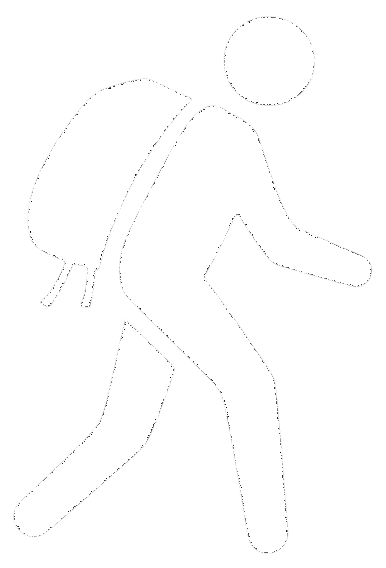Once you feel the thrill of rucking and experience health benefits, you will want to ruck all the time. That’s when the question of how often should you ruck arises.
I am telling you this from personal experience. A few months after I started to ruck, I was practically “addicted” and forgot how important rest and recovery are, even though I have experience from other sports.
Determining the ideal frequency of rucking is crucial; otherwise, daily workouts will prevent you from getting all the benefits this magnificent activity provides.
In this comprehensive guide, I’ll explore the various factors that influence the rucking frequency and provide actionable tips for finding the ideal frequency to suit your needs.
Understanding the Basics of Rucking
Let’s get back to the basics. Whether you are a beginner or a seasoned rucker, it is always good to think about the basics. This can help you come up with many answers, including how often you should ruck.
For a more detailed dive into rucking strategies and optimization, consider checking out some excellent books on rucking to guide your journey.
Rucking is basically walking with a weighted backpack, which cannot be characterized as a low-impact activity because it is more demanding than walking. However, some people wonder, is rucking bad for your knees? While it is more challenging than regular walking, it is undoubtedly not as high-impact as running.
If you’re braving the cold months to keep up with your routine, you’ll need to adjust your approach. Learning how to handle rucking in cold weather is so important for staying safe and enjoying your workout in harsh conditions. It’s one thing to sweat it out in summer, but another to carry weight while fighting frostbite!
Over time, consistent rucking will help you build up strength in various muscle groups, including your rucking calves, which develop as you continue to ruck regularly. Proper technique and weight management can reduce stress on the lower body while helping to build muscle.
That’s why this aerobic exercise, rooted in military training, can be practiced relatively often but usually not daily. Still, it is undoubtedly not as high-impact as running. That’s why it can be practiced relatively more often compared to some other activities.
It’s simple to tailor rucking to individual fitness levels by adjusting the backpack’s weight and the duration or intensity of the walk. As long as you use the optimal weight of at least 10-15% of your body weight, you can expect to improve cardiovascular health and aerobic capacity, strengthen muscles, burn calories, and relax from stress.
Don’t forget that proper equipment is crucial for safe and effective rucking, no matter if you ruck twice a month or twice a week. Just because you’re not that frequent on the trail doesn’t mean it’s okay to ruck with running shoes and laptop bag.
The most important piece of equipment is a well-fitted backpack or a weighted vest with a place for a ruck plate. In addition to the backpack, you have to invest in rucking boots or shoes. If you have flat feet or want to improve comfort, you can also add insoles.
Over time, you will buy other rucking accessories like hydration bladder and ruck pants.
Importance of Individual Factors
Why can’t I just give you the perfect rucking frequency right now? As with any form of exercise, fitness level, age, and overall health are determining factors for optimal frequency.
You can’t overlook health problems and go full speed four times a week just because you want to. It doesn’t even have to be health problems, but your level of experience and fitness.
For beginners or those who took a long break, you must start slowly and allow your body time to adapt to the new physical demands. A good approach is to start with one to two rucking sessions per week.
Advanced ruckers, who have built up their endurance and strength over time, can withstand higher frequencies and greater intensities. They might ruck up to five times a week or go long distance with heavy load.
Goal-Oriented Rucking Frequency
My experience as a fitness and strength&conditioning coach has shown me that the best results are achieved when we have explicit goals.
So, your specific goals should dictate how often you will engage in rucking sessions.
Weight Loss and Fat Burning
If you are looking to shed pounds, you must have a consistent schedule of rucking. On average, three to five times per week is most effective. Rucking workout, as a combination of aerobic training and resistance training, at this frequency helps to create a calorie deficit, which is the only way to lose extra weight. To get a clearer understanding of the impact, explore how many calories does rucking burn during a typical session.
However, please don’t believe in magic solutions; losing pounds is pretty straightforward. Rucking alone will not be enough to make you reach your weight loss goals, so a balanced diet plays an equally huge role.
Muscle Building and Strength Gain
It’s a bit trickier with muscle building and strength improvement.
Doing rucking session alongside weight training workouts is the best way to stimulate muscle growth and enhance rucking performance. Since it is hard, you must have plenty of time to recover, so aim for two to three times per week, at least at the beginning. That’s how you will complete your strength training plan.
Other goals
If your goal is to relax after a hard day and connect with nature, then you have the freedom to determine the perfect frequency for you. Rucking is an activity that should bring you physical benefits along with enjoyment, but if you prefer a more leisurely walk through nature, consider backpacking too. The choice is yours.
Balancing Frequency with Recovery
I’ll be honest with you: finding the right balance is challenging, even for professional athletes and coaches in high-profile sports. I’m not telling you to discourage you but to emphasize how important it is for the striker to strike a balance between rucking frequency and adequate rest and recovery.
Your body must have enough time to recover between rucking sessions to prevent injuries and maintain long-term consistency. Here’s how to integrate rest and recovery effectively into your training program.
Incorporating Rest Days
Rest days are essential for muscle recovery, as they provide the necessary downtime for muscles to heal and grow stronger after the physical stress of rucking. You actually make progress during rest days. When you ruck marching, you stimulate your muscles, and then adaptation to imposed demands occurs during rest days.
A good approach is scheduling at least one to two rest days per week, especially if you’re rucking three to five times weekly. These rest days do not have to mean complete inactivity; light activities like walking, yoga, or stretching can promote blood flow and aid in recovery without putting additional strain on your muscles. Anyway, I recommend at least one day weekly dedicated to total rest, and sleep is the most important.
Recovery Strategies
Things you can do to help your body recover are stretching, foam rolling, and, above all — proper nutrition. Also, do what you know you like. If you are experienced not only in rucking but also in sports in general, you surely have your own routine that helps you feel good and speed up recovery.
I cannot emphasize enough the importance of nutrition. A balanced diet rich in proteins, carbohydrates, and healthy fats provides the necessary nutrients for muscle repair and energy replenishment. Occasional cheat meals are also helpful for both your mind and body. Hydration is equally important.
Progressive Overload and Frequency
For me, progressive overload is the most important principle in strength training and to build muscle mass. It is also totally relevant to rucking. You have to increase the frequency and intensity of sessions over time, which will challenge your body and promote adaptation. You must not do it too slowly because you will stagnate, nor too fast, so as not to injure yourself or experience burnout.
Start with a moderate frequency of rucking sessions. Later, you can increase the frequency, duration, or even both, but moderately. In addition to adjusting frequency, experiment with different weights, speeds, or terrains.
Take control of ruck training by closely monitoring changes in your physical performance, muscle soreness, and overall well-being. Modern technologies, like fitness apps and smartwatches, are your allies in this. They allow you to monitor your heart rate, time, and other parameters, giving you the power to know when it’s time to rest or when you’re ready to push for a personal best. This level of control is key to your long-term progress.
Later, record these metrics in a journal or fitness app to monitor your condition in the long term. That way, you will find patterns that you will later be able to use during the GoRuck challenge; for example, if you eat more carbs, you can ruck longer or less than seven hours of sleep translates into poor performance. These are general things, but you will notice your unique metrics through monitoring.
Listening to Your Body
We are not robots. Sometimes, we feel perfect, as if we can conquer the highest peak in the world, and sometimes, going to the supermarket seems like a challenge.
So, listen to your body. Occasionally, you may feel grumpy. You just need willpower to start, and within 15 minutes, you will feel great.
Yet, there will be situations when you are really not in top shape, and then you should not push yourself at all costs. Forget the Instagram and TikTok motivational videos that tell you never to give up. In some cases, staying in bed and watching TV are way more beneficial.
Of course, don’t use my words as an excuse all the time. If you feel like that every other day, you either need to see a doctor or you are just not committed enough.
When you are overtrained, you will notice signs. Persistent fatigue, irritability, decreased performance, and minor injuries practically daily are some of those signs.
If you wake up every morning tired even though you slept well, it means that your body is too exhausted. Overtraining occurs when your body lacks time to recover between rucking or other physical activity. Rucking doesn’t have to be the main culprit; maybe you’re just doing too much at work, and then even two rucks per week are excessive.
Flexibility in Frequency
Your training schedule is not written in stone.
Pushing too hard and stubbornly adhering to it will not benefit you. Remain flexible in your approach to rucking frequency, allowing for adjustments based on numerous factors. If you notice a plateau in your progress or feel signs of overtraining, consider reducing the frequency or intensity of your sessions to give your body more time to recover. Conversely, if you find that your current routine is becoming too easy, push harder to continue challenging your body.
In Summary
Finding the ideal frequency for rucking requires consideration of individual factors, goals, and recovery needs.
Once you grasp the basics of rucking, learn to listen to your body, and monitor progress, you will be able to easily tailor your frequency to maximize results plus enjoyment and achieve your fitness objectives.
Remember to keep rest and recovery high on the priority list, and don’t hesitate to adjust your frequency to maintain a balanced and sustainable rucking routine. Just because you are reducing the frequency does not mean that you are regressing; on the contrary, you will progress in your rucking journey once you are past overtraining or a plateau.
Frequently Asked Questions (FAQ)
Are there specific age groups that should adjust their rucking frequency?
While rucking can be suitable for individuals of all ages, older adults must adjust their frequency and ruck weight. They have to take physical limitations and health concerns into account. Younger individuals have different recovery capabilities and fitness goals that dictate their ideal rucking frequency.
How does rucking frequency vary between different terrains and environments?
Rucking frequency varies depending on the terrain and environment in which you’re rucking. For example, rucking in the city allows for more frequent sessions than on uphill routes. Similarly, environmental factors such as temperature and humidity affect how often you ruck.
Can rucking frequency affect my mental health and well-being?
Absolutely, rucking can have positive effects on mental health and overall well-being. It reduces stress, improves mood, and enhances cognitive function.
It’s important to note that rucking too often can lead not just to physical, but also mental fatigue, and even burnout. Signs that you may be pushing yourself too hard include lack of motivation, brain fog, persistent fatigue, increased joint pain, and decreased performance. Recognizing these signs is crucial for maintaining a healthy rucking routine.
Can rucking frequency impact my sleep quality and patterns?
Yes, regular rucking will make you sleep better. Such activities promote better sleep by helping regulate circadian rhythms, making you tired, and reducing stress. Nevertheless, avoid intense rucking too close to bedtime, as the adrenaline rush interferes with sleep.
References
Peterson MD, Pistilli E, Haff GG, Hoffman EP, Gordon PM. Progression of volume load and muscular adaptation during resistance exercise. Eur J Appl Physiol. 2011 Jun;111(6):1063-71. doi: 10.1007/s00421-010-1735-9. Epub 2010 Nov 27. PMID: 21113614; PMCID: PMC4215195.
Plotkin D, Coleman M, Van Every D, Maldonado J, Oberlin D, Israetel M, Feather J, Alto A, Vigotsky AD, Schoenfeld BJ. Progressive overload without progressing load? The effects of load or repetition progression on muscular adaptations. PeerJ. 2022 Sep 30;10:e14142. doi: 10.7717/peerj.14142. PMID: 36199287; PMCID: PMC9528903.
Earl-Boehm JE, Poel DN, Zalewski K, Ebersole KT. The effects of military style ruck marching on lower extremity loading and muscular, physiological and perceived exertion in ROTC cadets. Ergonomics. 2020 May;63(5):629-638. doi: 10.1080/00140139.2020.1745900. Epub 2020 Apr 2. PMID: 32191155.








